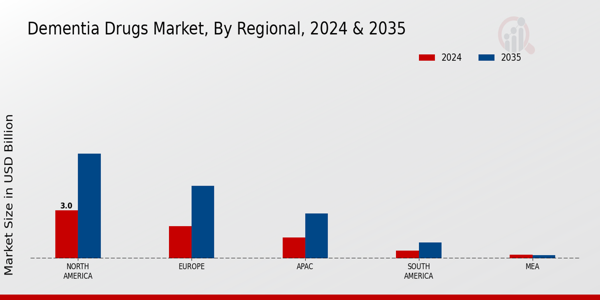Growing Demand for Combination Therapies
The increasing demand for combination therapies is emerging as a significant driver in the Dementia Drugs Market. Healthcare professionals are recognizing that a multifaceted approach to treatment may yield better outcomes for patients with dementia. Combination therapies, which involve the use of multiple drugs to target different pathways of the disease, are gaining traction. This trend is supported by clinical evidence suggesting that such approaches can enhance cognitive function and slow disease progression. As a result, pharmaceutical companies are likely to focus on developing combination therapies, which could lead to a diversification of treatment options available in the Dementia Drugs Market.
Advancements in Drug Development Technologies
Technological advancements in drug development are significantly influencing the Dementia Drugs Market. Innovations such as artificial intelligence and machine learning are streamlining the drug discovery process, enabling researchers to identify potential therapeutic targets more efficiently. Moreover, the integration of biomarkers in clinical trials is enhancing the precision of drug efficacy assessments. As a result, the time required to bring new dementia drugs to market is potentially reduced, which may lead to a more dynamic and responsive market. The emergence of novel drug delivery systems also holds promise for improving patient compliance and treatment outcomes, thereby fostering growth within the Dementia Drugs Market.
Increased Awareness and Education on Dementia
Rising awareness and education regarding dementia are pivotal in shaping the Dementia Drugs Market. Public health campaigns and educational initiatives are effectively informing communities about the symptoms and risks associated with dementia, leading to earlier diagnosis and treatment. This heightened awareness is likely to drive demand for dementia drugs, as individuals seek medical intervention sooner. Furthermore, healthcare providers are increasingly prioritizing dementia care, which may result in more comprehensive treatment plans that include pharmacological options. Consequently, the growing emphasis on dementia education is expected to contribute positively to the expansion of the Dementia Drugs Market.
Aging Population and Rising Incidence of Dementia
The increasing aging population is a primary driver of the Dementia Drugs Market. As life expectancy rises, the prevalence of dementia is expected to escalate, with estimates suggesting that by 2030, approximately 75 million individuals may be living with dementia. This demographic shift necessitates the development and availability of effective dementia drugs, thereby propelling market growth. The rising incidence of dementia-related disorders, including Alzheimer's disease, further emphasizes the urgent need for innovative treatment options. Consequently, pharmaceutical companies are likely to invest heavily in research and development to address this growing health crisis, which in turn could lead to a surge in the Dementia Drugs Market.
Government Initiatives and Funding for Dementia Research
Government initiatives aimed at combating dementia are crucial for the advancement of the Dementia Drugs Market. Various countries are allocating substantial funding to support research and development in dementia therapies. For instance, national health organizations are establishing grants and programs to encourage innovation in drug development. These initiatives not only facilitate the discovery of new treatments but also enhance collaboration between academic institutions and pharmaceutical companies. As a result, the influx of government support is likely to accelerate the pace of research, ultimately leading to a more robust pipeline of dementia drugs in the market. This trend underscores the importance of public investment in addressing the dementia crisis.


















Leave a Comment